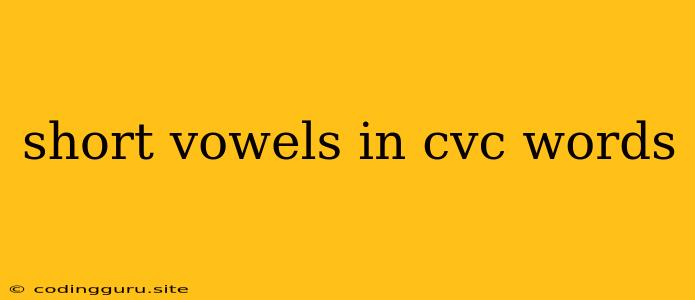Unveiling the Secrets of Short Vowels in CVC Words
Have you ever wondered why the "a" in "cat" sounds different from the "a" in "cake"? Or why "dog" has a short "o" sound while "go" has a long "o" sound? The answer lies in the magical world of short vowels in CVC words.
What are CVC words?
CVC stands for Consonant - Vowel - Consonant. These are simple, three-letter words that are fundamental to early literacy development. Examples of CVC words include: cat, dog, sun, bed, hop, and bug.
What are Short Vowels?
Short vowels are the sounds that we make when we pronounce the letters a, e, i, o, and u quickly and without extending the sound. Imagine you are saying them very briefly, as if you were in a hurry.
How do short vowels work in CVC words?
In CVC words, the vowel is sandwiched between two consonants. This sandwiching action creates a short vowel sound. The vowel is not allowed to "stretch" out, it stays short and snappy.
Let's look at some examples:
- Cat: The short "a" sound is trapped between the "c" and the "t".
- Dog: The short "o" sound is trapped between the "d" and the "g".
- Sun: The short "u" sound is trapped between the "s" and the "n".
Why are short vowels in CVC words important?
Understanding short vowels in CVC words is crucial for young learners for several reasons:
- Foundation for reading: CVC words form the building blocks of reading. Mastering these simple words helps children develop a strong foundation for decoding longer and more complex words.
- Phonics skills: Recognizing the short vowel sound in CVC words is a key phonics skill that helps children sound out words.
- Spelling skills: Knowing the short vowel sounds helps children spell CVC words correctly.
How can we help children learn about short vowels in CVC words?
Here are some fun and engaging tips:
- Use visual aids: Create flashcards with CVC words and pictures. Use different colors to highlight the short vowel sound.
- Sing songs: Many catchy songs and rhymes focus on short vowels in CVC words.
- Play games: Play word games like "I Spy" or "Bingo" using CVC words.
- Use manipulatives: Use blocks or other objects to represent the letters in CVC words.
- Read books: Find books with lots of CVC words.
Examples of Activities for Learning Short Vowels in CVC Words:
Activity 1: Vowel Sort
- Materials: Flashcards with CVC words, three baskets labeled "Short A", "Short E", and "Short I".
- Instructions: Have children look at the flashcards and sort them into the correct baskets based on the short vowel sound.
Activity 2: CVC Word Hunt
- Materials: A picture book with lots of CVC words.
- Instructions: Have children search for CVC words in the book and say the short vowel sound.
Activity 3: Build a Word
- Materials: Letter tiles or magnetic letters.
- Instructions: Have children build CVC words using the letter tiles.
Conclusion:
Understanding short vowels in CVC words is fundamental for early literacy development. By engaging children in fun and interactive activities, we can help them master these crucial building blocks of reading and spelling. As children progress in their literacy journey, they will be able to confidently decode more complex words and become proficient readers.
